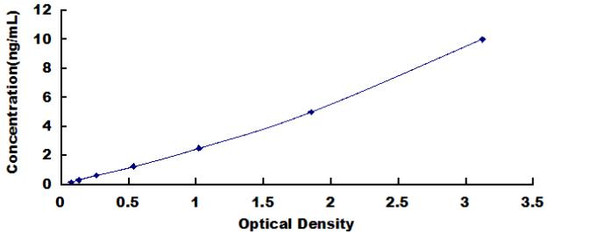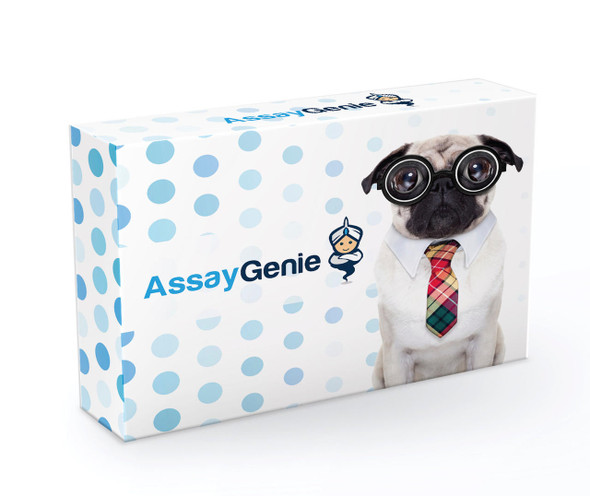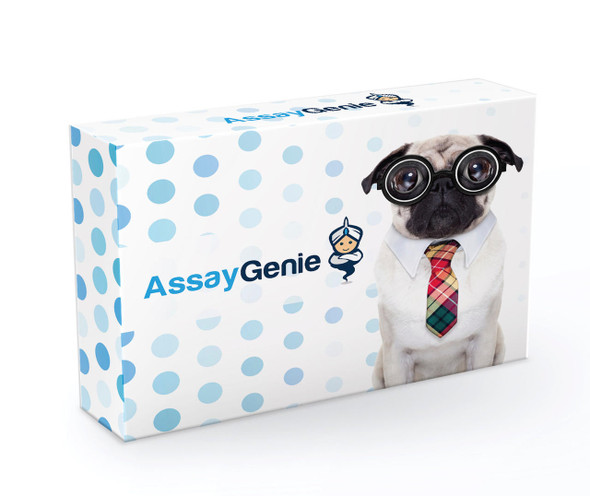Human Cell Death ELISA Kits
Human TP63 (Tumor Protein p63) CLIA Kit (HUES01197)
- SKU:
- HUES01197
- Product Type:
- ELISA Kit
- ELISA Type:
- CLIA Kit
- Size:
- 96 Assays
- Sensitivity:
- 18.75pg/mL
- Range:
- 31.25-2000pg/mL
- ELISA Type:
- Sandwich
- Reactivity:
- Human
- Sample Type:
- Serum, plasma and other biological fluids
- Research Area:
- Cell Death
Description
| Assay type: | Sandwich |
| Format: | 96T |
| Assay time: | 4.5h |
| Reactivity: | Human |
| Detection method: | Chemiluminescence |
| Detection range: | 31.25-2000 pg/mL |
| Sensitivity: | 18.75 pg/mL |
| Sample volume: | 100µL |
| Sample type: | Serum, plasma and other biological fluids |
| Repeatability: | CV < 15% |
| Specificity: | This kit recognizes Human TP63 in samples. No significant cross-reactivity or interference between Human TP63 and analogues was observed. |
This kit uses Sandwich-CLIA as the method. The micro CLIA plate provided in this kit has been pre-coated with an antibody specific to Human TP63. Standards or samples are added to the appropriate micro CLIA plate wells and combined with the specific antibody. Then a biotinylated detection antibody specific for Human TP63 and Avidin-Horseradish Peroxidase (HRP) conjugate are added to each micro plate well successively and incubated. Free components are washed away. The substrate solution is added to each well. Only those wells that contain Human TP63, biotinylated detection antibody and Avidin-HRP conjugate will appear fluorescence. The Relative light unit (RLU) value is measured spectrophotometrically by the Chemiluminescence immunoassay analyzer. The RLU value is positively associated with the concentration of Human TP63. The concentration of Human TP63 in the samples can be calculated by comparing the RLU of the samples to the standard curve.
| UniProt Protein Function: | Function: Acts as a sequence specific DNA binding transcriptional activator or repressor. The isoforms contain a varying set of transactivation and auto-regulating transactivation inhibiting domains thus showing an isoform specificactivity. Isoform 2 activates RIPK4 transcription. May be required in conjunction with TP73/p73 for initiation of p53/TP53 dependent apoptosis in response to genotoxic insults and the presence of activated oncogenes. Involved in Notch signaling by probably inducing JAG1 and JAG2. Plays a role in the regulation of epithelial morphogenesis. The ratio of DeltaN-type and TA*-type isoforms may govern the maintenance of epithelial stem cell compartments and regulate the initiation of epithelial stratification from the undifferentiated embryonal ectoderm. Required for limb formation from the apical ectodermal ridge. Activates transcription of the p21 promoter. Ref. 3 Ref. 15 Ref. 17 Ref. 18 Ref. 19 Ref. 23 Ref. 24 |
| UniProt Protein Details: | Cofactor: Binds 1 zinc ion per subunit By similarity. Subunit structure: Binds DNA as a homotetramer. Isoform compositionof the tetramer may determine transactivation activity. Isoforms Alpha and Gamma interact with HIPK2. Interacts with SSRP1, leading to stimulate coactivator activity. Isoform 1 and isoform 2 interact with WWP1. Interacts with PDS5A. Isoform 5 (via activation domain) interacts with NOC2L. Ref. 10 Ref. 13 Ref. 16 Ref. 19 Ref. 21 Ref. 22 Ref. 23 Subcellular location: Nucleus Ref. 17 Ref. 23. Tissue specificity: Widely expressed, notably in heart, kidney, placenta, prostate, skeletal muscle, testis and thymus, although the precise isoform variesaccording to tissue type. Progenitor cell layers of skin, breast, eye and prostate express high levels of DeltaN-type isoforms. Isoform 10 is predominantly expressed in skin squamous cell carcinomas, but not in normal skin tissues. Ref. 3 Ref. 8 Ref. 14 Domain: The transactivation inhibitory domain (TID) can interact with, and inhibit the activity of the N-terminal transcriptional activation domain of TA*-type isoforms. Ref. 17 Ref. 18 Post-translational modification: May be sumoylated By similarity. Ubiquitinated. Polyubiquitination involves WWP1 and leads to proteasomal degradation of this protein. Ref. 21 Involvement in Disease: Acro-dermato-ungual-lacrimal-tooth syndrome (ADULT syndrome) [MIM:103285]: A form of ectodermal dysplasia. Ectodermal dysplasia defines a heterogeneous group of disorders due to abnormal development of two or more ectodermal structures. ADULT syndrome involves ectrodactyly, syndactyly, finger- and toenail dysplasia, hypoplastic breasts and nipples, intensive freckling, lacrimal duct atresia, frontal alopecia, primary hypodontia and loss of permanent teeth. ADULT syndrome differs significantly from EEC3 syndrome by the absence of facial clefting. Note: The disease is caused by mutations affecting the gene represented in this entry. Ankyloblepharon-ectodermal defects-cleft lip/palate (AEC) [MIM:106260]: An autosomal dominant condition characterized by congenital ectodermal dysplasia with coarse, wiry, sparse hair, dystrophic nails, slight hypohidrosis, scalp infections, ankyloblepharon filiform adnatum, maxillary hypoplasia, hypodontia and cleft lip/palate. Note: The disease is caused by mutations affecting the gene represented in this entry. Ref. 29Ectrodactyly, ectodermal dysplasia, and cleft lip/palate syndrome 3 (EEC3) [MIM:604292]: A form of ectodermal dysplasia, a heterogeneous group of disorders due to abnormal development of two or more ectodermal structures. It is an autosomal dominant syndrome characterized by ectrodactyly of hands and feet, ectodermal dysplasia and facial clefting. Note: The disease is caused by mutations affecting the gene represented in this entry. Ref. 26 Ref. 27 Ref. 30 Ref. 32Split-hand/foot malformation 4 (SHFM4) [MIM:605289]: A limb malformation involving the central rays of the autopod and presenting with syndactyly, median clefts of the hands and feet, and aplasia and/or hypoplasia of the phalanges, metacarpals, and metatarsals. Some patients have been found to have mental retardation, ectodermal and craniofacial findings, and orofacial clefting. Note: The disease is caused by mutations affecting the gene represented in this entry. Ref. 27 Ref. 30Limb-mammary syndrome (LMS) [MIM:603543]: Characterized by ectrodactyly, cleft palate and mammary-gland abnormalities. Note: The disease is caused by mutations affecting the gene represented in this entry. Ref. 30Defects in TP63 are a cause of cervical, colon, head and neck, lung and ovarian cancers. Ectodermal dysplasia, Rapp-Hodgkin type (EDRH) [MIM:129400]: A form of ectodermal dysplasia, a heterogeneous group of disorders due to abnormal development of two or more ectodermal structures. Characterized by the combination of anhidrotic ectodermal dysplasia, cleft lip, and cleft palate. The clinical syndrome is comprised of a characteristic facies (narrow nose and small mouth), wiry, slow-growing, and uncombable hair, sparse eyelashes and eyebrows, obstructed lacrimal puncta/epiphora, bilateral stenosis of external auditory canals, microsomia, hypodontia, cone-shaped incisors, enamel hypoplasia, dystrophic nails, and cleft lip/cleft palate. Note: The disease is caused by mutations affecting the gene represented in this entry. Ref. 33 Ref. 34 Ref. 35 Ref. 36Non-syndromic orofacial cleft 8 (OFC8) [MIM:129400]: A birth defect consisting of cleft lips with or without cleft palate. Cleft lips are associated with cleft palate in two-third of cases. A cleft lip can occur on one or both sides and range in severity from a simple notch in the upper lip to a complete opening in the lip extending into the floor of the nostril and involving the upper gum. Note: The disease is caused by mutations affecting the gene represented in this entry. Sequence similarities: Belongs to the p53 family. Contains 1 SAM (sterile alpha motif) domain. Sequence caution: The sequence AAF43486. 1 differs from that shown. Reason: Erroneous initiation. The sequence AAF43487. 1 differs from that shown. Reason: Erroneous initiation. The sequence AAF43488. 1 differs from that shown. Reason: Erroneous initiation. The sequence AAF43489. 1 differs from that shown. Reason: Erroneous initiation. The sequence AAF61624. 1 differs from that shown. Reason: Frameshift at position 26. The sequence BAA32592. 1 differs from that shown. Reason: Frameshift at position 26. The sequence BAA32593. 1 differs from that shown. Reason: Frameshift at position 26. |
| NCBI Summary: | This gene encodes a member of the p53 family of transcription factors. An animal model, p63 -/- mice, has been useful in defining the role this protein plays in the development and maintenance of stratified epithelial tissues. p63 -/- mice have several developmental defects which include the lack of limbs and other tissues, such as teeth and mammary glands, which develop as a result of interactions between mesenchyme and epithelium. Mutations in this gene are associated with ectodermal dysplasia, and cleft lip/palate syndrome 3 (EEC3); split-hand/foot malformation 4 (SHFM4); ankyloblepharon-ectodermal defects-cleft lip/palate; ADULT syndrome (acro-dermato-ungual-lacrimal-tooth); limb-mammary syndrome; Rap-Hodgkin syndrome (RHS); and orofacial cleft 8. Both alternative splicing and the use of alternative promoters results in multiple transcript variants encoding different proteins. Many transcripts encoding different proteins have been reported but the biological validity and the full-length nature of these variants have not been determined. [provided by RefSeq, Jul 2008] |
| UniProt Code: | Q9H3D4 |
| NCBI GenInfo Identifier: | 57013009 |
| NCBI Gene ID: | 8626 |
| NCBI Accession: | Q9H3D4. 1 |
| UniProt Secondary Accession: | Q9H3D4,O75080, O75195, O75922, O76078, Q6VEG2, Q6VEG3 Q6VEG4, Q6VFJ1, Q6VFJ2, Q6VFJ3, Q6VH20, |
| UniProt Related Accession: | Q9H3D4 |
| Molecular Weight: | |
| NCBI Full Name: | Tumor protein 63 |
| NCBI Synonym Full Names: | tumor protein p63 |
| NCBI Official Symbol: | TP63 |
| NCBI Official Synonym Symbols: | AIS; KET; LMS; NBP; RHS; p40; p51; p63; EEC3; OFC8; p73H; p73L; SHFM4; TP53L; TP73L; p53CP; TP53CP; B(p51A); B(p51B) |
| NCBI Protein Information: | tumor protein 63; CUSP; transformation-related protein 63; tumor protein p53-competing protein; amplified in squamous cell carcinoma; chronic ulcerative stomatitis protein; keratinocyte transcription factor KET; tumor protein p63 deltaN isoform delta |
| UniProt Protein Name: | Tumor protein 63 |
| UniProt Synonym Protein Names: | Chronic ulcerative stomatitis protein; CUSP; Keratinocyte transcription factor KET; Transformation-related protein 63; TP63; Tumor protein p73-like; p73L; p40; p51 |
| Protein Family: | |
| UniProt Gene Name: | TP63 |
| UniProt Entry Name: | P63_HUMAN |
As the RLU values of the standard curve may vary according to the conditions of the actual assay performance (e. g. operator, pipetting technique, washing technique or temperature effects), the operator should establish a standard curve for each test. Typical standard curve and data is provided below for reference only.
| Concentration (pg/mL) | RLU | Average | Corrected |
| 2000 | 52773 58669 | 55721 | 55693 |
| 1000 | 22613 25335 | 23974 | 23946 |
| 500 | 11974 10090 | 11032 | 11004 |
| 250 | 5071 5517 | 5294 | 5266 |
| 125 | 2675 2541 | 2608 | 2580 |
| 62.5 | 1314 1308 | 1311 | 1283 |
| 31.25 | 648 700 | 674 | 646 |
| 0 | 27 29 | 28 | -- |
Precision
Intra-assay Precision (Precision within an assay): 3 samples with low, mid range and high level Human TP63 were tested 20 times on one plate, respectively.
Inter-assay Precision (Precision between assays): 3 samples with low, mid range and high level Human TP63 were tested on 3 different plates, 20 replicates in each plate.
| Intra-assay Precision | Inter-assay Precision | |||||
| Sample | 1 | 2 | 3 | 1 | 2 | 3 |
| n | 20 | 20 | 20 | 20 | 20 | 20 |
| Mean (pg/mL) | 96.88 | 281.05 | 954.41 | 97.33 | 298.16 | 1028.76 |
| Standard deviation | 8.74 | 20.71 | 83.03 | 9.84 | 21.86 | 64.40 |
| C V (%) | 9.02 | 7.37 | 8.70 | 10.11 | 7.33 | 6.26 |
Recovery
The recovery of Human TP63 spiked at three different levels in samples throughout the range of the assay was evaluated in various matrices.
| Sample Type | Range (%) | Average Recovery (%) |
| Serum (n=5) | 91-103 | 97 |
| EDTA plasma (n=5) | 88-104 | 95 |
| Cell culture media (n=5) | 101-113 | 106 |
Linearity
Samples were spiked with high concentrations of Human TP63 and diluted with Reference Standard & Sample Diluent to produce samples with values within the range of the assay.
| Serum (n=5) | EDTA plasma (n=5) | Cell culture media (n=5) | ||
| 1:2 | Range (%) | 86-99 | 88-100 | 100-116 |
| Average (%) | 93 | 94 | 106 | |
| 1:4 | Range (%) | 94-110 | 87-101 | 91-102 |
| Average (%) | 101 | 92 | 96 | |
| 1:8 | Range (%) | 97-110 | 85-98 | 85-97 |
| Average (%) | 102 | 90 | 91 | |
| 1:16 | Range (%) | 86-98 | 99-117 | 85-96 |
| Average (%) | 92 | 107 | 91 |
An unopened kit can be stored at 4°C for 1 month. If the kit is not used within 1 month, store the items separately according to the following conditions once the kit is received.
| Item | Specifications | Storage |
| Micro CLIA Plate(Dismountable) | 8 wells ×12 strips | -20°C, 6 months |
| Reference Standard | 2 vials | |
| Concentrated Biotinylated Detection Ab (100×) | 1 vial, 120 µL | |
| Concentrated HRP Conjugate (100×) | 1 vial, 120 µL | -20°C(shading light), 6 months |
| Reference Standard & Sample Diluent | 1 vial, 20 mL | 4°C, 6 months |
| Biotinylated Detection Ab Diluent | 1 vial, 14 mL | |
| HRP Conjugate Diluent | 1 vial, 14 mL | |
| Concentrated Wash Buffer (25×) | 1 vial, 30 mL | |
| Substrate Reagent A | 1 vial, 5 mL | 4°C (shading light) |
| Substrate Reagent B | 1 vial, 5 mL | 4°C (shading light) |
| Plate Sealer | 5 pieces | |
| Product Description | 1 copy | |
| Certificate of Analysis | 1 copy |
- Set standard, test sample and control (zero) wells on the pre-coated plate and record theirpositions. It is recommended to measure each standard and sample in duplicate. Note: addall solutions to the bottom of the plate wells while avoiding contact with the well walls. Ensuresolutions do not foam when adding to the wells.
- Aliquot 100 µL of standard solutions into the standard wells.
- Add 100 µL of Sample / Standard dilution buffer into the control (zero) well.
- Add 100 µL of properly diluted sample (serum, plasma, tissue homogenates and otherbiological fluids. ) into test sample wells.
- Cover the plate with the sealer provided in the kit and incubate for 90 min at 37 °C.
- Aspirate the liquid from each well, do not wash. Immediately add 100 µL of BiotinylatedDetection Ab working solution to each well. Cover the plate with a plate seal and gently mix. Incubate for 1 hour at 37 °C.
- Aspirate or decant the solution from the plate and add 350 µL of wash buffer to each welland incubate for 1-2 minutes at room temperature. Aspirate the solution from each well andclap the plate on absorbent filter paper to dry. Repeat this process 3 times. Note: a microplatewasher can be used in this step and other wash steps.
- Add 100 µL of HRP Conjugate working solution to each well. Cover with a plate seal andincubate for 30 min at 37 °C.
- Aspirate or decant the solution from each well. Repeat the wash process for five times asconducted in step 7.
- Add 100 µL of Substrate mixture solution to each well. Cover with a new plate seal andincubate for no more than 5 min at 37 °C. Protect the plate from light.
- Determine the RLU value of each well immediately.






